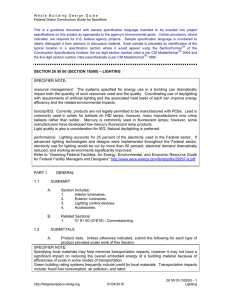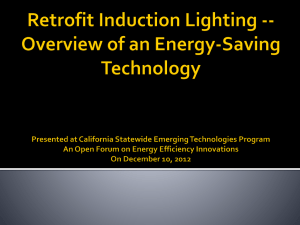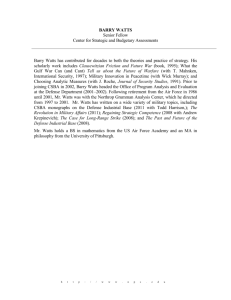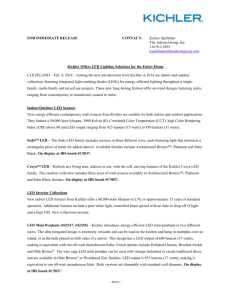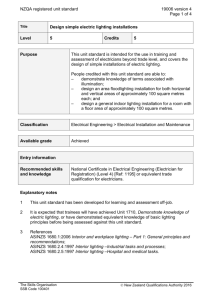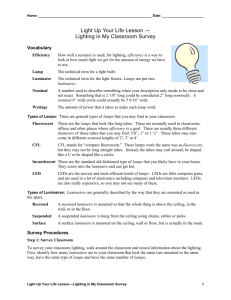1 - The Whole Building Design Guide
advertisement
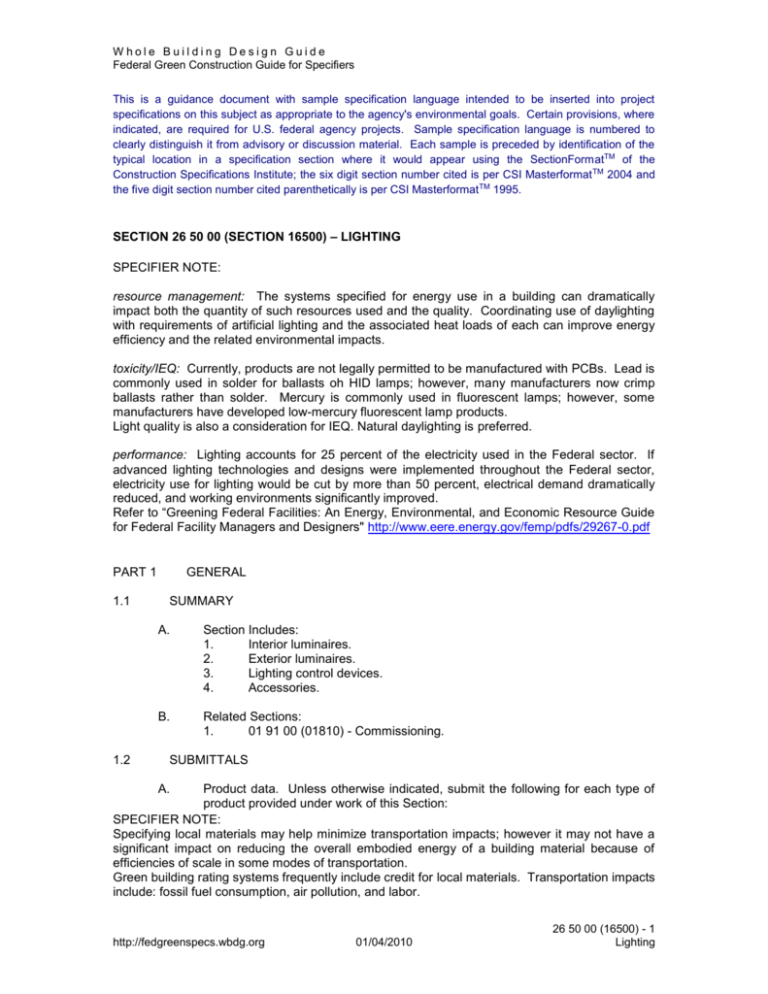
Whole Building Design Guide Federal Green Construction Guide for Specifiers This is a guidance document with sample specification language intended to be inserted into project specifications on this subject as appropriate to the agency's environmental goals. Certain provisions, where indicated, are required for U.S. federal agency projects. Sample specification language is numbered to clearly distinguish it from advisory or discussion material. Each sample is preceded by identification of the typical location in a specification section where it would appear using the SectionFormatTM of the Construction Specifications Institute; the six digit section number cited is per CSI Masterformat TM 2004 and the five digit section number cited parenthetically is per CSI Masterformat TM 1995. SECTION 26 50 00 (SECTION 16500) – LIGHTING SPECIFIER NOTE: resource management: The systems specified for energy use in a building can dramatically impact both the quantity of such resources used and the quality. Coordinating use of daylighting with requirements of artificial lighting and the associated heat loads of each can improve energy efficiency and the related environmental impacts. toxicity/IEQ: Currently, products are not legally permitted to be manufactured with PCBs. Lead is commonly used in solder for ballasts oh HID lamps; however, many manufacturers now crimp ballasts rather than solder. Mercury is commonly used in fluorescent lamps; however, some manufacturers have developed low-mercury fluorescent lamp products. Light quality is also a consideration for IEQ. Natural daylighting is preferred. performance: Lighting accounts for 25 percent of the electricity used in the Federal sector. If advanced lighting technologies and designs were implemented throughout the Federal sector, electricity use for lighting would be cut by more than 50 percent, electrical demand dramatically reduced, and working environments significantly improved. Refer to “Greening Federal Facilities: An Energy, Environmental, and Economic Resource Guide for Federal Facility Managers and Designers" http://www.eere.energy.gov/femp/pdfs/29267-0.pdf PART 1 1.1 1.2 GENERAL SUMMARY A. Section Includes: 1. Interior luminaires. 2. Exterior luminaires. 3. Lighting control devices. 4. Accessories. B. Related Sections: 1. 01 91 00 (01810) - Commissioning. SUBMITTALS A. Product data. Unless otherwise indicated, submit the following for each type of product provided under work of this Section: SPECIFIER NOTE: Specifying local materials may help minimize transportation impacts; however it may not have a significant impact on reducing the overall embodied energy of a building material because of efficiencies of scale in some modes of transportation. Green building rating systems frequently include credit for local materials. Transportation impacts include: fossil fuel consumption, air pollution, and labor. http://fedgreenspecs.wbdg.org 01/04/2010 26 50 00 (16500) - 1 Lighting Whole Building Design Guide Federal Green Construction Guide for Specifiers USGBC-LEED™ v3 includes credits for materials extracted/harvested and manufactured within a 500 mile radius from the project site. Green Globes US also provides points for materials that are locally manufactured. 1. Local/Regional Materials: a. Sourcing location(s): Indicate location of extraction, harvesting, and recovery; indicate distance between extraction, harvesting, and recovery and the project site. b. Manufacturing location(s): Indicate location of manufacturing facility; indicate distance between manufacturing facility and the project site. c. Product Value: Indicate dollar value of product containing local/regional materials; include materials cost only. d. Product Component(s) Value: Where product components are sourced or manufactured in separate locations, provide location information for each component. Indicate the percentage by weight of each component per unit of product. SPECIFIER NOTE: The EPA has developed minimum energy efficiency standards for Energy Star labeled products. EPA Energy Star categories include: appliances, HVAC, residential equipment, office equipment, and lighting. USGBC-LEED™ v3 include credits for increasing levels of energy performance, referencing IESNA/ASHRAE 90.1 as the standard for establishing baseline performance. Energy systems addressed include: HVAC, service hot water, and interior lighting. Plug loads, exterior lighting, garage ventilation, and vertical transportation (elevators) are not included. 2. Energy Efficiency: a. b. c. B. Submit documentation for Energy Star qualifications for equipment provided under work of this Section. Submit data indicating lumens per watt efficiency of light source. Submit data indicating color rendition index of light source. Submit environmental data in accordance with Table 1 of ASTM E2129 for products provided under work of this Section. SPECIFIER NOTE: Identify special maintenance agreements. Maintenance agreements are standard practice in the building industry. Take-back programs refer to programs in which the product manufacturer “takes-back” scrap material and/or packaging associated with its product. Green leasing is a new, but dramatic shift in the traditional perspective of leased equipment. Under a green lease, the product manufacturer is responsible for the disposition of the product at all times. Thus, when the customer no longer requires the use of the particular product or requires an updated model, the manufacturer is obligated to reclaim it and refurbish it or disassemble it for recycling as appropriate. This approach necessitates a revision of administrative services. It also requires a basic redesign of products in order to allow for future disassembly and upgrade. This has the potential to be cost effective for manufacturers and customers alike. It is also extremely resource efficient. C. Documentation of manufacturer’s [maintenance agreement] [take-back program] [green lease] for luminaires. Include the following: 1. Appropriate contact information. 2. Overview of procedures. a. Indicate manufacturer’s commitment to reclaim materials for recycling and/or reuse. 3. Limitations and conditions, if any, applicable to the project. http://fedgreenspecs.wbdg.org 01/04/2010 26 50 00 (16500) - 2 Lighting Whole Building Design Guide Federal Green Construction Guide for Specifiers 1.3 QUALITY ASSURANCE A. 1.4 Energy Efficiency: lighting products. Comply with National Energy Policy Act requirements for MAINTENANCE Operational Service: Provide manufacturer’s [maintenance agreement] [takeback program] [green lease] service for luminaires installed in project. Service shall reclaim materials for recycling and/or reuse. Service shall not landfill or burn reclaimed materials. SPECIFIER NOTE: For disposal information regarding mercury, refer to the EPA Mercury website http://www.epa.gov/mercury/index.html 1. Indicate procedures for compliance with regulations governing disposal of Mercury. A. PART 2 PRODUCTS SPECIFIER NOTE: EO 13423 includes requirements for Federal Agencies to “… improve energy efficiency and reduce greenhouse gas emissions … by (i) 3 percent annually through the end of fiscal year 2015, or (ii) 30 percent by the end of fiscal year 2015, relative to the baseline of … year 2003” Specifically, under the Sustainable Building requirements per Guiding Principle #2 Optimize Energy Performance, EO 13423 directs Federal agencies to “design to earn the Energy Star targets for new construction and major renovation” and, for “new construction, reduce the energy cost budget by 30 percent compared to the baseline building performance rating per the American Society of Heating, Refrigerating and Air-Conditioning Engineers, Inc., (ASHRAE) and the Illuminating Engineering Society of North America (IESNA) Standard 90.1-2004, Energy Standard for Buildings Except Low-Rise Residential. For major renovations, reduce the energy cost budget by 20 percent below pre-renovations 2003 baseline.” Executive Order 13514; Federal Leadership in Environmental, Energy, and Economic Performance; was signed on October 5, 2009. http://www.ofee.gov/execorders.asp It expands upon the environmental performance requirements of EO 13423. http://www1.eere.energy.gov/femp/regulations/printable_versions/eo13423.html EO 13514 sets numerous federal requirements in several areas, including sustainable buildings and communities. Federal agencies must implement high performance sustainable federal building design, construction, operation and management, maintenance, and deconstruction, including: Ensuring all new Federal buildings, entering the design phase in 2020 or later, are designed to achieve zero net energy by 2030. Ensuring all new construction, major renovations, or repair or alteration of Federal buildings comply with the Guiding Principles of Federal Leadership in High Performance and Sustainable Buildings http://www1.eere.energy.gov/femp/pdfs/mouhighperfsustainfedfacs.pdf Ensuring at least 15% of existing agency buildings and leases (above 5,000 gross square feet) meet the Guiding Principles by fiscal year 2015 and that the agency makes annual progress towards 100% compliance across its building inventory. 2.1 INTERIOR LUMINAIRES SPECIFIER NOTE: The Federal Energy Management Program (FEMP) provides procurement guidelines with http://fedgreenspecs.wbdg.org 01/04/2010 26 50 00 (16500) - 3 Lighting Whole Building Design Guide Federal Green Construction Guide for Specifiers efficiency recommendations for products as indicated below. Decisions as to appropriateness of equipment design are dependent upon project goals and location. Refer to http://www.eere.energy.gov/femp/technologies/eeproducts.cfm Lumen is a measure of light output. Ballast efficacy factor (BEF) is the ratio of the ballast factor (BF) to input watts; it measures the efficiency of the lamp/ballast system relative to others using the same type and number of lamps. Ballast factor (BF), also called relative light output (RLO), is the ratio of the light output of a lamp(s) operated by a ballast, to the light output of the same lamp(s) operated by a reference ballast at rated current and voltage. Upward efficiency is the portion of light directed up. Both high-bay and low-bay luminaires are available with opaque reflectors, which direct all or most of the light downward, and with transparent refractors, which direct some light up. LER, or luminaire efficacy rating, describes the efficiency of a luminaire in terms of rated light output (in lumens) per watt of electricity use. A lumen is a standard measure of light output. A. Fluorescent Tube Lamp: FEMP Efficiency Recommendation Lamp Type Recommended Best Available Four-Foot Lamps T8, 32 watts 2800 lumens or more 3000 lumens T12, 34 watts 2800 lumens or more 2900 lumens Eight-Foot Lamps T8,59 watts 5700 lumens or more 5950 lumens T12,34 watts 2800 lumens or more 2900 lumens Eight-Foot Lamps T8,59 watts 5700 lumens or more 5950 lumens T12,60 watts 5600 lumens or more 6000 lumens U-Tube Lamps T8/U,31-32 watts 2600 lumens or more 2850 lumens T12/U,34 watts 2700 lumens or more 2760 lumens B. Fluorescent Ballast: FEMP Efficiency Recommendation Lamp Type # of Lamps Recommended BEF Best Available BEF Four-Foot and U-Tube Lamps T8,32 Watts 1 2.54 or higher 3.00 2 1.44 or higher 1.54 3 0.93 or higher 1.06 4 0.73 or higher 0.79 T12,34 Watts 1 2.64 or higher 3.05 2 1.41 or higher 1.53 3 0.93 or higher 0.95 Eight-Foot Lamps T8,59 Watts 2 0.80 or higher 0.81 T12,60 Watts 2 0.80 or higher 0.80 C. Industrial Luminaires: FEMP Performance Requirements for Federal Purchases Fluorescent T5HO Lamps http://fedgreenspecs.wbdg.org 01/04/2010 26 50 00 (16500) - 4 Lighting Whole Building Design Guide Federal Green Construction Guide for Specifiers Required Luminaire Efficacy Rating (LER) Lensed Fixture Open Fixture 0% 63 or higher 75 or higher Greater than 0% 65 or higher 78 or higher Fluorescent High Performance T8 Lamps Required Luminaire Efficacy Rating (LER) Upward Efficiency Lensed Fixture Open Fixture 0% 72 or higher 87 or higher Greater than 0% 75 or higher 90 or higher Metal Halide Lamps Required Luminaire Efficacy Rating (LER) Upward Efficiency Lamp Wattage Lensed Fixture Open Fixture 150 - 399 50 or higher 49 or higher 0% 400 - 999 62 or higher 69 or higher ≥1000 84 or higher 76 or higher 150 - 399 68 or higher 49 or higher 1% - 10% 400 - 999 73 or higher 75 or higher ≥1000 71 or higher 96 or higher 150 - 399 70 or higher 55 or higher 11% - 20% 400 - 999 76 or higher 81 or higher ≥1000 82 or higher 87 or higher 150 - 399 76 or higher 80 or higher >20% 400 - 999 76 or higher 70 or higher ≥1000 87 or higher 93 or higher Upward Efficiency D. Downlight Luminaires; FEMP Performance Requirement for Federal Purchases Compact Fluorescent Lamps Luminaire Type Required Luminaire Efficacy Rating (LER) Open Optics 29 or higher Baffled Optics 21 or higher Lensed Optics 24 or higher Metal Halide Lamps Luminaire Type Required Luminaire Efficacy Rating (LER) Open Optics 35 or higher Lensed Optics 30 or higher E. Fluorescent Luminaires: FEMP Performance Requirement for Federal Purchases Luminaire Type Required LER Number Required LER (NEMA (Programmedof Lamps (Instant-Start) Designation) Start) 2' x 4' Recessed 2 74 or higher 69 or higher Lensed (FL) 3 71 or higher 68 or higher 4 68 or higher 63 or higher 2 61 or higher 56 or higher VDT-Preferred Louvered (FP) 3 60 or higher 57 or higher http://fedgreenspecs.wbdg.org 01/04/2010 26 50 00 (16500) - 5 Lighting Whole Building Design Guide Federal Green Construction Guide for Specifiers 4 Four-Foot (FW) Four-Foot (FS) VDT-preferred Lensed 60 or higher Plastic Wraparound 2 71 or higher 4 69 or higher Strip Lights 1 82 or higher 2 77 or higher 2' x 2' Recessed with U-Tube Lamps 2 50 or higher 2 60 or higher 57 or higher 66 or higher 64 or higher 75 or higher 71 or higher 46 or higher 56 or higher F. Compact Fluorescent Lamps: FEMP Performance Requirement for Federal Purchases To Replace Typical CFL Necessary Required CFL Incandescent Replacement Light Output Lumens per Watt Bulb Rate At: Wattage (Lumens) (lpw) Bare Bulbs 40 watts 11-14 watts 495 or more 45 lpw or more 60 watts 15-19 watts 900 or more 60 lpw or more 75 watts 20-25 watts 1200 or more 60 lpw or more 100 watts ? 29 watts 1750 or more 60 lpw or more Reflector Type Bulbs 50 watts 17-19 watts 550 or more 33 lpw or more 60 watts 20-21 watts 675 or more 40 lpw or more 75 watts ? 22 watts 875 or more 40 lpw or more G. 2.2 Exit Sign: UL listed. Provide with automatic power failure device, [test switch, pilot light,] [integral self-testing module] and fully automatic high/low trickle charger in a self-contained power pack. Battery shall be sealed electrolyte type, shall operate unattended, and require no maintenance, including no additional water, for a period of not less than 5 years. LED exit sign shall have emergency run time of 1 1/2 hours (minimum). The light emitting diodes shall have rated lamp life of 70,000 hours (minimum). Product Type Recommended All Fixtures 5 watts or less EXTERIOR LUMINAIRES A. Luminaire: SPECIFIER NOTE: USGBC-LEED™ v3 include credit for eliminating light trespass from the building and site; credit includes requirement that exterior luminaires have power densities in compliance with ASHRAE/IESNA Standard 90.1-2007 for the classified zone with classification in accordance with IESNA RP-33. 1. IESNA Classification: [LZ1 – dark] [LZ2 – low] [ LZ3 – medium] [LZ4 high]. 2. Photometric Performance of installed units: Maximum initial horizontal illumination does not exceed [xxxx] footcandles at a point lighting level readings should be measured at [grade] [xxxx]. http://fedgreenspecs.wbdg.org 01/04/2010 26 50 00 (16500) - 6 Lighting Whole Building Design Guide Federal Green Construction Guide for Specifiers 2.3 2.4 LIGHTING CONTROL DEVICES A. Dimming Ballast Controls: Sliding-handle type with on/off control; compatible with ballast and having light output and energy input over the full dimming range. B. Light Level Sensor: Detect changes in ambient lighting level and provide dimming range of 20 to 100 percent in response to change. Sensor shall be capable of controlling 40 electronic dimming ballast, minimum. Adjustable Ambient Detection Range: [10 to 100] [xxxx] footcandles minimum. Sensor shall have a bypass function to electrically override sensor control. C. Occupancy Sensors: Comply with Green Seal GC-12. Provide adjustable sensitivity and off delay time range of 5 to 15 minutes. 1. [Ultrasonic Sensors: Crystal controlled with circuitry that causes no detection interference between adjacent sensors.] 2. [Infrared Sensors: With daylight filter and lens to afford coverage applicable to space to be controlled.] 3. [Combination Sensors: Ultrasonic and infrared sensors combined]. 4. [Microwave and audiophonic sensors.] D. Time Switch: Astronomic dial type or electronic type, arranged to turn "ON" at sunset and turn "OFF" at predetermined time between 8:30 p.m. and 2:30 a.m. or sunrise, automatically changing the settings each day in accordance with seasonal changes of sunset and sunrise. 1. Provide switch rated [xxxx] volts, having automatically wound spring mechanism or capacitor, to maintain accurate time for a minimum of 15 hours following power failure. 2. Provide time switch with a manual on-off bypass switch. 3. Housing: [surface] [flush]-mounted, NEMA [1] [3] [xxxx] enclosure conforming to NEMA ICS 6. E. Photocell Switch: UL 773 or UL 773A, hermetically sealed cadmium-sulfide or silicon diode type cell rated [xxxx] volts ac, 60 Hz with [single-throw contacts] [single pole double-throw contacts] for control of mechanically held contactors, rated [1000] [xxxx] W. 1. Switch shall turn on at or below 32 lux (3 footcandles) and off at 22 to 107 lux (92 to 10 footcandles). 2. A time delay shall prevent accidental switching from transient light sources. 3. Provide switch: a. [Integral to the luminaire. rated 1000W minimum.] [Provide a directional lens in front of the cell to prevent fixed light sources from creating a turnoff condition.] b. [In a U.V. stabilized polycarbonate housing with swivel arm and adjustable window slide, rated 1800 VA, minimum.] c. [In a high-impact-resistant, noncorroding and nonconductive molded plastic housing with a locking-type receptacle conforming to IEEE C136.10, rated 1800 VA, minimum.] d. [In a cast weatherproof aluminum housing with adjustable window slide, rated 1800 VA, minimum.] ACCESSORIES SPECIFIER NOTE: http://fedgreenspecs.wbdg.org 01/04/2010 26 50 00 (16500) - 7 Lighting Whole Building Design Guide Federal Green Construction Guide for Specifiers Labeling of lighting components is an inexpensive and effective method for helping facilities personnel properly operate and maintain the lighting systems. The labels should be easy to read when standing next to the equipment, and durable to match the life of the equipment to which they are attached. Refer to the FEMP guidelines for lighting http://www1.eere.energy.gov/femp/technologies/eep_lighting_guidance.html A. Labels: Provide labels luminaires. Include the following information on each label: 1. All luminaires shall be clearly marked for operation of specific lamps and ballasts and according to proper lamp type in accordance with UL 1570 or UL 1572 requirements, as applicable. 2. For maintenance purposes, the following lamp characteristics should be noted, as applicable, in the format "Use Lamps Only": a Lamp diameter code (T-4, T-5, T-8, T-12), tube configuration (twin, quad, triple), base type, and nominal wattage for fluorescent and compact fluorescent luminaires. b Lamp type, wattage, bulb type (ED17, BD56, etc.) and coating (clear or coated) for HID luminaires. c Start type (preheat, rapid start, instant start) for fluorescent and compact fluorescent luminaires. d. ANSI ballast type (M98, M57, etc.) for HID luminaires. e Correlated color temperature (CCT) and color rendering index (CRI) for all luminaires. 3. All markings related to lamp type shall be clear and located to be readily visible to service personnel, but invisible from normal viewing angles when lamps are in place. 4. Ballasts shall have clear markings indicating multi-level outputs and indicate proper terminals for the various outputs. PART 3 - EXECUTION 3.X SITE ENVIRONMENTAL PROCEDURES A. Resource Management: 1. Energy Efficiency: Verify equipment is properly installed, connected, and adjusted. Verify that equipment is operating as specified. a. Electronic Dimming Ballast: Test for full range of dimming capability. Observe for visually detectable flicker over full dimming range. b. Occupancy Sensor: Test sensors for proper operation. Observe for light control over entire area being covered. 2. Coordinate with manufacturer for [maintenance agreement] [take-back program] [green lease]. END OF SECTION http://fedgreenspecs.wbdg.org 01/04/2010 26 50 00 (16500) - 8 Lighting
